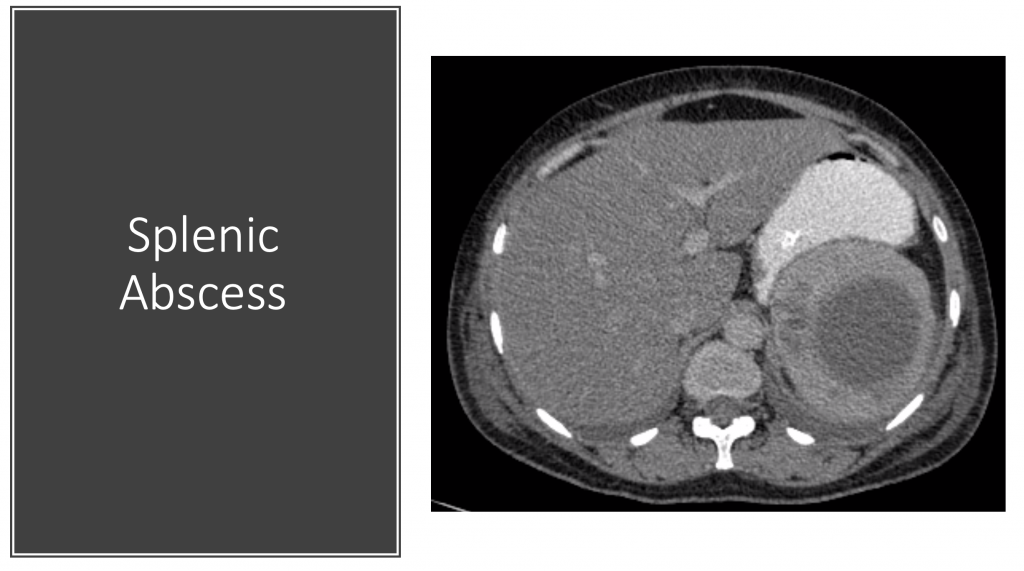Author: Alec Pawlukiewicz, MD (EM Resident Physician, San Antonio, TX) // Reviewed by: Brit Long, MD (@long_brit, EM Attending Physician, San Antonio, TX) and Alex Koyfman, MD (@EMHighAK, EM Attending Physician, UTSW / Parkland Memorial Hospital)
Case:
You are working a shift in the ED when you see that the next patient is a 64-year-old female with a chief complaint of abdominal pain. She has a past medical history notable for diabetes, hypertension, hyperlipidemia, and prior splenic infarction. Upon taking her history, she reports 2 weeks of fever, malaise, generalized weakness, and moderate, pleuritic left-sided abdominal pain. Her vital signs are notable for HR 102, RR 18, BP 152/83, SpO2 of 98% on RA, Temp 100.9F. Physical exam is notable for slightly decreased breath sounds at the left lung base and moderate left upper quadrant tenderness without rebound or guarding.
Background:
Splenic abscesses are an uncommon disease, with retrospective studies reporting annual incidence rates of 0.05%-0.7%.1–3 Because of the uncommon nature of this disease, the majority of the literature on the subject of splenic abscesses is based on case reports, case series, and small retrospective studies.
Splenic abscesses typically arise via one of three etiologies: endocarditis with seeding of septic emboli, bacteremia and subsequent splenic seeding, or spread of contiguous infection.1,4–6 Risk factors that predispose individuals to the development of splenic abscesses include immunosuppression (in particular HIV, chronic liver disease, and diabetes), prior splenic infarction, hemoglobinopathies, splenic trauma, and endocarditis.7–10
Clinical Presentation:
Common presenting symptoms of splenic abscesses include fever (68.7-95.9%), left upper quadrant/left flank pain (37.5-71%), and nausea/vomiting (46%).6,8,11–15 The presenting fever may be of acute onset or have had a more protracted course over the preceding weeks, typically resistant to a prior course of antibiotics. Patients with left diaphragmatic irritation may also present with left shoulder pain and hiccups.13 Patients may also develop a left-sided pleural effusion resulting in a pleuritic nature to their presenting pain.11 Patients with splenic abscesses typically have left upper quadrant tenderness to palpation (44.7%) and splenomegaly (32.4-55.1%) on presentation; however, these findings may be absent in patients with deeper abscesses.6,8,11–16
Finally, patients may present with signs and symptoms of endocarditis or the contiguous infection (pneumonia, bowel perforation, etc.) that led to the splenic abscess.
Laboratory Evaluation and Imaging:
Laboratory evaluation and imaging should be guided by the patient presentation. In patients with splenic abscesses, lab findings may include leukocytosis with a left-shift (79.6-93.7%).6–8,11–16 Blood cultures may be useful in identifying the causative organism in patients presenting with significant systemic symptoms (43.7-65.3%).8,11,14,17,18 A chest x-ray may show a left-sided pleural effusion (45.5-55.1%).11,13,14
The diagnostic imaging of choice in patients with splenic abscesses is a CT scan of the abdomen and pelvis with intravenous contrast with sensitivity of 92.2-98% (Fig. 1).1,18,19 However, ultrasound or MRI may also be used to further characterize splenic lesions as needed.4

Treatment:
The initial treatment of splenic abscesses begins with the early initiation of antibiotics and fluid resuscitation as needed. Because the pathogen(s) responsible for the splenic abscess can vary widely based on both geographic region and inciting etiology, broad-spectrum antibiotics covering gram-positive, gram-negative, and anaerobic species should be started initially.8,18 Possible appropriate initial regimens include vancomycin and piperacillin-tazobactam or vancomycin, cefepime, and metronidazole. The microbiological etiology of splenic abscesses is most frequently polymicrobial and may consist of both aerobic and anaerobic species.8 The most common aerobic pathogens include E. coli, S. aureus, and Streptococcus spp.8 The most common anaerobic isolates include Peptostreptococcus spp, Bacteroides spp, and Clostridium spp.8 Antibiotic therapy may then be tailored to cover the causative pathogen once blood and abscess culture data has been obtained.18
After initial fluid resuscitation and antibiotic therapy, source control should be obtained.18 This can be done through either splenectomy or CT-guided drainage (Fig. 2) by Interventional Radiology. While traditionally splenectomy is the gold standard treatment for patients with splenic abscesses, more recent studies have advocated CT-guided aspiration.20Because no randomized controlled trials have been conducted regarding the management of splenic abscesses, the recommendations for management are based heavily on retrospective data and expert opinion. The current IDSA recommendation for the management of complicated intra-abdominal infections and abscesses is that “[w]here feasible, percutaneous drainage of abscesses and other well-localized fluid collections is preferable to surgical drainage.”18 This is because recent advances in percutaneous drainage techniques have improved outcome to the extent that “many abscesses that were previously considered to be best approached by laparotomy are now often approached by interventional radiography.”18
Benefits to CT-guided aspiration include providing source control in patient who are poor surgical candidates, decreasing the risk of overwhelming sepsis post-splenectomy, and maintenance of viable splenic tissue and its subsequent immunologic function.21

Contraindications to CT-guided aspiration include loculated or debris filled abscesses, perforated abscesses, multiple small abscesses, patients with other indications for surgery (i.e. generalized peritonitis, abscesses secondary to a cause that will require surgical repair), and abscesses poorly characterized by CT and diffuse ascites.15,22
However, because there is no clear consensus on management of splenic abscesses, the particulars of each individual patient should be discussed with the consulting services to best tailor management to the case at hand.
Disposition:
Patients presenting to the ED diagnosed with splenic abscesses should be admitted for further antibiotic therapy and source control.
Prognosis:
Studies describing the mortality rate of patients with splenic abscesses vary dramatically, citing rates from 0% in selected subsets of patients to nearly 100% in patients with delayed or inappropriate therapy.9,11,23 The absence of prospective studies on the natural history of splenic abscesses leads to uncertainty concerning mortality rates and relative treatment efficacies. Because of the significant increase in mortality with missed and delayed diagnosis, a high level of clinical suspicion must be maintained, particularly in subsets of patients with risk factors for developing splenic abscesses.24 Prognostic factors associated with an increased mortality rate include gram negative bacilli as the microbiologic etiology, multiple abscesses at the time of diagnosis and an APACHE score of greater than 15 at initial presentation.1
Take Home Points:
- Keep a high clinical suspicion for splenic abscesses. Because of the increased mortality with missed and delayed diagnoses, a high level of clinical suspicion must be maintained, particularly in subsets of patients at higher risk of developing splenic abscesses.
- Assess for secondary source of infection in patients found to have splenic abscesses. Because splenic abscesses are often associated with endocarditis, bacteremia, or the spread of contiguous infection, be sure to thoroughly assess patients found to have splenic abscesses for secondary sources of infection.
- Consider consulting Interventional Radiology for source control. While the gold standard for source control of splenic abscesses has traditionally been splenectomy, recent evidence and expert opinion has advocated for percutaneous drainage where feasible. Because there is no clear consensus on management, discuss the case with both General Surgery and Interventional Radiology.
Case Resolution:
ED evaluation reveals leukocytosis with neutrophil predominance, a chest x-ray with a left-sided pleural effusion, and a CT scan of the abdomen and pelvis with IV contrast demonstrating an 8 cm splenic abscess. The patient is adequately fluid resuscitated, blood cultures are obtained, and broad-spectrum antibiotics are initiated. General Surgery and Interventional Radiology are consulted, and the decision is made to admit the patient for further antibiotics and CT-guided percutaneous drainage.
Resources/Further Reading:
- Chang K-C, Chuah S-K, Changchien C-S, et al. Clinical characteristics and prognostic factors of splenic abscess: A review of 67 cases in a single medical center of Taiwan. World J Gastroenterol. 2006;12(3):460. doi:10.3748/wjg.v12.i3.460
- Westh H, Reines E, Skibsted L. Splenic Abscesses: A Review of 20 Cases. Scand J Infect Dis. 1990;22(5):569-573. doi:10.3109/00365549009027098
- Al-Hajjar N, Graur F, Hassan AB, Molnár G. Splenic abscesses. Rom J Gastroenterol. 2002;11(1):57-59. http://www.ncbi.nlm.nih.gov/pubmed/12096316. Accessed September 15, 2019.
- Thipphavong S, Duigenan S, Schindera ST, Gee MS, Philips S. Nonneoplastic, Benign, and Malignant Splenic Diseases: Cross-Sectional Imaging Findings and Rare Disease Entities. Am J Roentgenol. 2014;203(2):315-322. doi:10.2214/AJR.13.11777
- Kamaya A, Weinstein S, Desser TS. Multiple Lesions of the Spleen: Differential Diagnosis of Cystic and Solid Lesions. Semin Ultrasound, CT MRI. 2006;27(5):389-403. doi:10.1053/J.SULT.2006.06.004
- Robinson SL, Saxe JM, Lucas CE, Arbulu A, Ledgerwood AM, Lucas WF. Splenic abscess associated with endocarditis. Surgery. 1992;112(4):781-786; discussion 786-7. http://www.ncbi.nlm.nih.gov/pubmed/1411951. Accessed September 12, 2019.
- Ng K, Lee T, Wan Y, Tan C, … KL-H, 2002undefined. Splenic abscess: diagnosis and management. europepmc.org. https://europepmc.org/abstract/med/11995499. Accessed September 15, 2019.
- Brook I, Frazier EH. Microbiology of liver and spleen abscesses. J Med Microbiol. 1998;47(12):1075-1080. doi:10.1099/00222615-47-12-1075
- Al-Salem AH, Qaisaruddin S, Al Jam’a A, Al-Kalaf J, El-Bashier AM. Splenic abscess and sickle cell disease. Am J Hematol. 1998;58(2):100-104. doi:10.1002/(sici)1096-8652(199806)58:2<100::aid-ajh2>3.0.co;2-w
- Ulhaci N, Meteoğlu I, Kacar F, Ozbaş S. Abscess of the spleen. Pathol Oncol Res. 2004;10(4):234-236. doi:PAOR.2004.10.4.0234
- Lee M-C, Lee C-M. Splenic Abscess: An Uncommon Entity with Potentially Life-Threatening Evolution. Can J Infect Dis Med Microbiol. 2018;2018:1-6. doi:10.1155/2018/8610657
- Ting W, Silverman NA, Arzouman DA, Levitsky S. Splenic septic emboli in endocarditis. Circulation. 1990;82(5 Suppl):IV105-9. http://www.ncbi.nlm.nih.gov/pubmed/2225394. Accessed September 12, 2019.
- Johnson JD, Raff MJ, Barnwell PA, Chun CH. Splenic abscess complicating infectious endocarditis. Arch Intern Med. 1983;143(5):906-912. http://www.ncbi.nlm.nih.gov/pubmed/6679235. Accessed September 15, 2019.
- Lee C-H, Leu H-S, Hu T-H, Liu J-W. Splenic abscess in southern Taiwan. J Microbiol Immunol Infect. 2004;37(1):39-44. http://www.ncbi.nlm.nih.gov/pubmed/15060686. Accessed September 12, 2019.
- Tung C-C, Chen F-C, Lo C-J. Splenic abscess: an easily overlooked disease? Am Surg. 2006;72(4):322-325. http://www.ncbi.nlm.nih.gov/pubmed/16676856. Accessed September 15, 2019.
- Alvi AR, Kulsoom S, Shamsi G. Splenic abscess: outcome and prognostic factors. J Coll Physicians Surg Pak. 2008;18(12):740-743. doi:12.2008/JCPSP.740743
- Divyashree S, Gupta N. Splenic Abscess in Immunocompetent Patients Managed Primarily without Splenectomy: A Series of 7 Cases. Perm J. 2017;21:16-139. doi:10.7812/TPP/16-139
- Solomkin JS, Mazuski JE, Bradley JS, et al. Diagnosis and Management of Complicated Intra‐abdominal Infection in Adults and Children: Guidelines by the Surgical Infection Society and the Infectious Diseases Society of America. Clin Infect Dis. 2010;50(2):133-164. doi:10.1086/649554
- P.J. Ooi LL, Leong SS. Splenic abscesses from 1987 to 1995. Am J Surg. 1997;174(1):87-93. doi:10.1016/S0002-9610(97)00030-5
- Thanos L, Dailiana T, Papaioannou G, Nikita A, Koutrouvelis H, Kelekis DA. Percutaneous CT-Guided Drainage of Splenic Abscess. Am J Roentgenol. 2002;179(3):629-632. doi:10.2214/ajr.179.3.1790629
- Faruque AV, Qazi SH, Arshad M, Anwar N. Isolated splenic abscess in children, role of splenic preservation. Pediatr Surg Int. 2013;29(8):787-790. doi:10.1007/s00383-013-3336-2
- Schäberle W, Eisele R. [Percutaneous ultrasound controlled drainage of large splenic abscesses]. Chirurg. 1997;68(7):744-748. http://www.ncbi.nlm.nih.gov/pubmed/9340244. Accessed September 15, 2019.
- Smyrniotis V, Kehagias D, Voros D, et al. Splenic Abscess. Dig Surg. 2000;17(4):354-357. doi:10.1159/000018878
- Liang J-T, Lee P-H, Wang S-M, Chang K-J. Splenic abscess: A diagnostic pitfall in the ED. Am J Emerg Med. 1995;13(3):337-343. doi:10.1016/0735-6757(95)90215-5







1 thought on “Splenic Abscess: ED Presentation, Evaluation, and Management”
Pingback: Quiz 49, November 1th, 2019